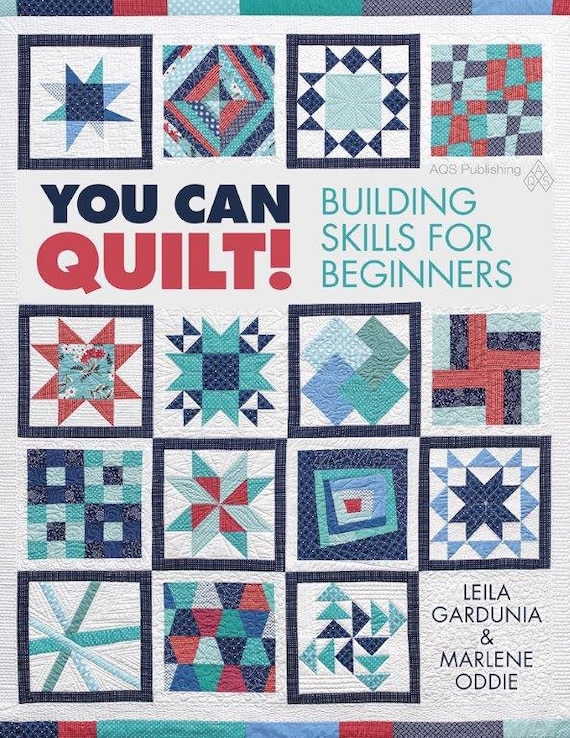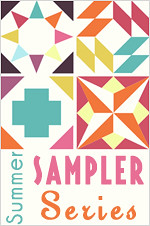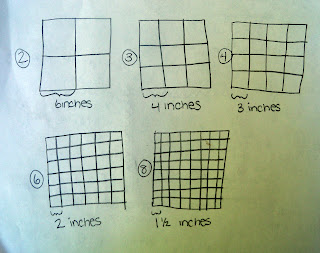There is no new block this week, but we are going to talk about "quilt math" and designing your own blocks. (Sad about no new block? Don't worry, I have a special block challenge at the end of this post, keep on reading. :) )
First, some definitions. A finished block, square or HST is one that is sewn onto other fabric on all four sides. It is the size you want the piece to be when your quilt is finished. Unfinished measurements include enough extra fabric for seam allowances. So our blocks are 12.5 inches square unfinished and 12 inches finished.
Why did I choose for our blocks to finish at 12 inches? First of all, the bigger the block, the easier it is to sew. Since we are working with new techniques I figured we could give ourselves a break. :) But almost more importantly a 12 inch block is very versatile.
It can be divided in 2, 3, 4, 6 and 8 evenly. This allows for a number of different blocks without working with weird fractions.
Let's say I wanted to design my own block and I want to have the block divided into 4 columns and rows. 12 divided by 4 is 3, so each square in my block has a finished size of 3x3 inches. I start sketching and divide the middle 4 squares on the diagonal and make a pinwheel design.

But it needs something more so I color in some squares radiating off from the pinwheel. Looks good! But I notice that the two white blocks on the sides could be combined. No point sewing two pieces of fabric together when you can just cut one, so I sketch the block again leaving out the lines that divided the two squares.
Here are the different pieces that I will need.

Now I need to figure out how large to cut my pieces. I know that each finished square is 3x3, the finished rectangles are 3x6 and the finished HST measure 3x3.
I will need to have a 1/4 inch on each side of the square and rectangle for the seam allowance. The finished height of the square + 1/4 inch on top + 1/4 inch on bottom = finished height + 1/2 inch.
The same holds for the width of the square and rectangle. Finished width +1/4 on the right +1/4 on the left = finished width +1/2.
The rule is to add 1/2 inch to the finished length and width of squares and rectangles in order to find the unfinished size that you need to cut out. So I would need to cut my square 3 1/2 x 3 1/2 inches and my rectangle 3 1/2 x 6 1/2 inches
Squares and Rectangles - add 1/2 inch to length and width


A HST unit is made out of two right triangles. Each triangle needs it's own seam allowance.
They need a 1/4 inch on the side with the 90 degree angle and a 1/4 inch seam at the point, but the point extends farther as it tappers down to a point from the necessary 1/4 inch. That extra length is 3/8 inch. Please, let's not go deeper into the geometry of it and just trust that it is so. :) I add 1/4 + 1/4 + 3/8 = 7/8.
I will need to cut squares 7/8 inch larger than the finished HSTs. In this case the squares I would use to make my HSTs would be 3 7/8 x3 7/8. If I planned to trim my HSTs to size I would cut my squares slightly larger, 4x4 inches.
Half Square Triangles - add 7/8 inch to the length and width of the squares you use to make them
(add 1 inch if you plan to trim to size)
Clear as mud?
To finish my block I would count up how many different shapes I needed.
4 light 3 1/2 x 6 1/2 inch rectangles
4 medium 3 1/2 x 3 1/2 inch squares
2 dark 3 7/8 x 3 7/8 inch squares
2 light 3 7/8 x 3 7/8 inch squares (or 4x4)
I would make my HSTs, attach them to the medium squares, sew the rectangles onto the sides and then join the four subsections into a whole block. And voila! My block would be done.
I know there is way too much math and way too few pretty pictures in this post. :) Please, if you have any questions let me know.
I have an optional challenge for you this week: design and make your own 12 inch finished block!
Sketch a large square and divide it into 4 sections length and width wise, just like I did. Now start sketching. You can use squares, triangles and rectangles. Here is a series of 4x4 blocks that I did to come up with ideas for a bee block. It doesn't have to be pretty! :)
Really, the possibilities are endless.
Feeling up to the challenge? You Can Do It! I would love to see what you make! (Flickr group
here.)
Be sure to leave a comment on the next post to be entered in the "I've Made All 3 Blocks!" giveaway.
 .
. 














































